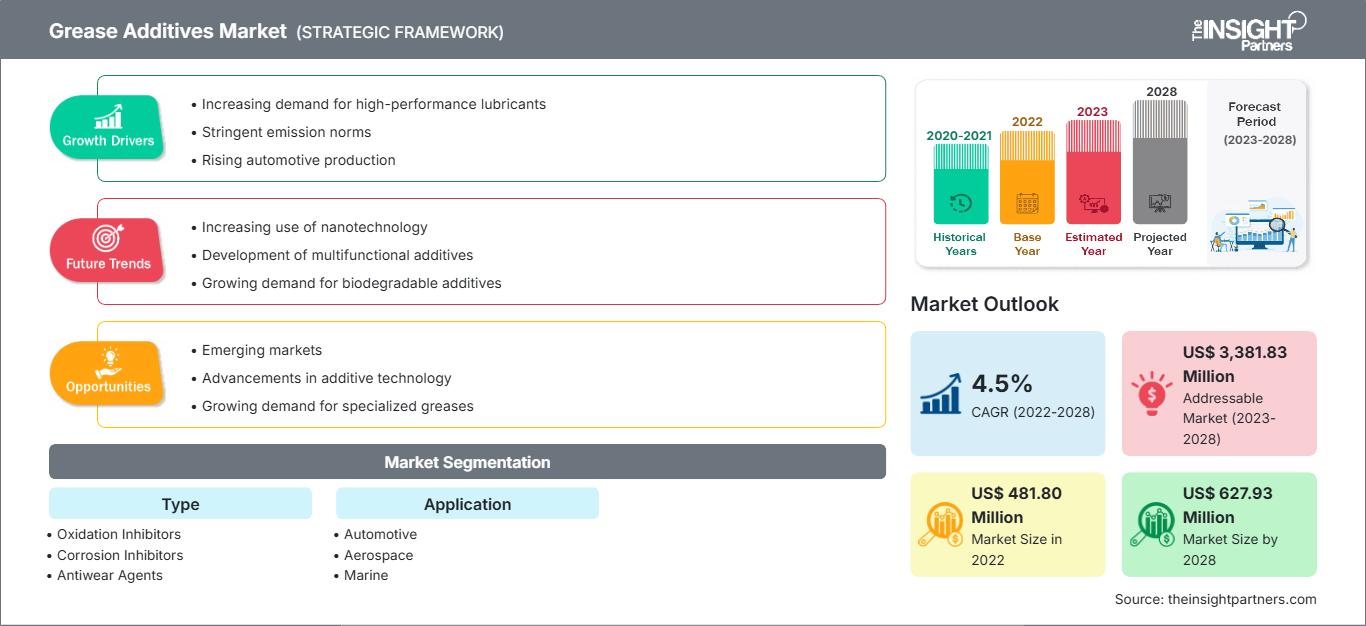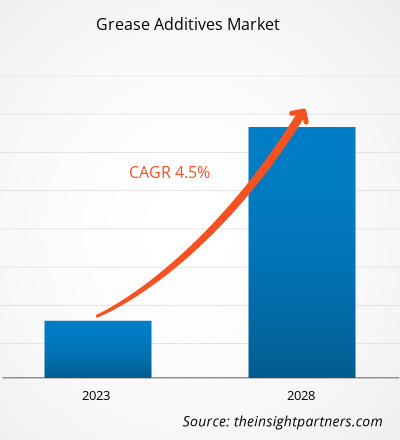[Informe de investigación] El tamaño del mercado de aditivos para grasas se valoró en 481,80 millones de dólares estadounidenses en 2022 y se prevé que alcance los 627,93 millones de dólares estadounidenses en 2028; se estima que crecerá a una tasa de crecimiento anual compuesta (TCAC) del 4,5 % entre 2022 y 2028.
Los aditivos para grasas son sustancias químicas orgánicas o inorgánicas que se disuelven o se suspenden en el aceite en forma sólida. El auge en las ventas de automóviles de pasajeros y vehículos comerciales está impulsando el mercado de aditivos para grasas. Estos aditivos se utilizan en grasas lubricantes para mejorar el rendimiento de los equipos y prolongar su vida útil.
Las grasas industriales se componen principalmente de aceite base, espesante y aditivos; estos últimos constituyen el segundo componente más importante después del aceite base. En la fabricación de grasas se utilizan tres tipos de aceites base: aceite mineral, aceite vegetal y aceite sintético. Las grasas sintéticas se fabrican con aceites sintéticos como la polialfaolefina. Su uso está muy extendido en el sector industrial, especialmente en la industria automotriz. Sus características superiores, su capacidad para garantizar la consistencia operativa y su precio asequible las convierten en una categoría de lubricantes preferida. Las grasas sintéticas se utilizan en aplicaciones que implican temperaturas, cargas y velocidades extremas. Los aditivos para grasas sintéticas mejoran las propiedades físicas y químicas al aumentar el índice de viscosidad, reducir la volatilidad y disminuir el punto de fluidez de los lubricantes. Entre las categorías de aditivos más utilizadas se encuentran los mejoradores del índice de viscosidad, los depresores del punto de fluidez, los dispersantes y los detergentes. Con la creciente demanda de grasas sintéticas, es probable que la necesidad de aditivos para estas grasas aumente considerablemente durante el período previsto.
Varios actores importantes del mercado están desarrollando aditivos para grasas sintéticas con el fin de mejorar su eficiencia. Por ejemplo, en septiembre de 2022, Clariant lanzó aditivos antidesgaste y de extrema presión, mejoradores de lubricidad, inhibidores de corrosión, agentes neutralizantes y formulaciones guía para fluidos de mecanizado de metales totalmente sintéticos que incrementan la eficiencia de las máquinas. Así, con la creciente demanda de grasas sintéticas, los aditivos utilizados en estas grasas están generando nuevas tendencias en el mercado de aditivos para grasas.
En 2022, Asia Pacífico ostentó la mayor cuota de mercado de aditivos para grasas y se estima que registrará la mayor tasa de crecimiento anual compuesto (TCAC) durante el período de previsión. Europa es otra región atractiva y posee una participación importante en el mercado. El creciente número de instalaciones de parques eólicos terrestres y marinos, junto con el aumento de la producción de automóviles, contribuyen al crecimiento del mercado de aditivos para grasas en Europa. Suecia, Finlandia, Alemania y Francia están experimentando un notable incremento en la instalación de aerogeneradores, impulsado por la creciente demanda de energías renovables. Según WindEurope VZW/ASBL, Europa registró 19,1 GW de nuevas instalaciones eólicas en 2022, incluyendo aproximadamente 16,7 GW en proyectos terrestres y 2,5 GW en proyectos marinos. La grasa se utiliza para mejorar el rendimiento de los aerogeneradores, ya que contribuye a su resistencia a la corrosión, el calor, las inclemencias del tiempo y las llamas.
Obtendrá personalización gratuita de cualquier informe, incluyendo partes de este informe, análisis a nivel de país y paquetes de datos de Excel. Además, podrá aprovechar excelentes ofertas y descuentos para empresas emergentes y universidades.
Mercado de aditivos para grasas: Perspectivas estratégicas

-
Obtenga las principales tendencias clave del mercado que se describen en este informe.Esta muestra GRATUITA incluirá análisis de datos, que abarcarán desde tendencias de mercado hasta estimaciones y pronósticos.
Impacto de la pandemia de COVID-19 en el mercado de aditivos para grasas
La pandemia de COVID-19 afectó a las economías e industrias de numerosos países en todo el mundo. Los confinamientos, las restricciones de viaje y el cierre de empresas en Norteamérica, Europa, Asia Pacífico (APAC), Sudamérica y Centroamérica, y Oriente Medio y África (MEA) obstaculizaron el crecimiento de diversas industrias, como la automotriz, la construcción, la aeroespacial y la minera. El cierre de las plantas de producción interrumpió las cadenas de suministro globales, las actividades de fabricación, los plazos de entrega y las ventas de productos, tanto esenciales como no esenciales. Varias empresas sufrieron retrasos en las entregas y una caída en las ventas de sus productos en 2020. Además, las prohibiciones de viajes internacionales impuestas por los gobiernos de diferentes países de Europa, Asia Pacífico y Norteamérica obligaron a las empresas a suspender temporalmente sus planes de colaboración y alianzas. Todos estos factores perjudicaron a diversas industrias en 2020 y principios de 2021, frenando así el crecimiento de múltiples mercados, incluido el de aditivos para grasas.
Durante la fase inicial de la pandemia de COVID-19, la implementación de restricciones de confinamiento y el cierre de plantas de producción provocaron una disminución de la producción, creando un desequilibrio entre la oferta y la demanda. Estos factores afectaron la rentabilidad de diversos fabricantes de aditivos para grasas, tanto pequeños como grandes. En 2021, varias economías reanudaron sus operaciones cuando los gobiernos de distintos países anunciaron la flexibilización de las restricciones impuestas, lo que impulsó el mercado global. Se permitió a los fabricantes operar a plena capacidad, lo que les ayudó a superar el desequilibrio entre la oferta y la demanda, así como otras repercusiones. La creciente demanda de maquinaria automotriz e industrial tras la pandemia de COVID-19 ha generado una mayor demanda de aditivos para grasas.
Perspectivas del mercado
Los avances estratégicos de los principales actores favorecen el crecimiento del mercado de aditivos para grasas.
Los principales actores del mercado están adoptando diversas estrategias de marketing, como el lanzamiento de productos, fusiones y adquisiciones y colaboraciones, que favorecen el crecimiento del mercado.
Información sobre tipos
Según su tipo, el mercado de aditivos para grasas se segmenta en inhibidores de oxidación, inhibidores de corrosión, agentes antidesgaste, aditivos de presión, desactivadores de metales y otros. El segmento de inhibidores de oxidación ostentó la mayor cuota de mercado en 2022. Se prevé que el segmento de aditivos de presión registre la mayor tasa de crecimiento anual compuesto (TCAC) durante el período de pronóstico. El crecimiento del mercado de aditivos para grasas en el segmento de aditivos de presión se atribuye a la creciente demanda de grasas en aplicaciones con condiciones de alta presión, como la industria aeroespacial, naval, minera y siderúrgica. Además, la creciente incidencia del desgaste mecánico en diversas aplicaciones subraya la necesidad de lubricantes de grasa eficaces complementados con los aditivos adecuados.
Afton Chemical Corp, BASF SE, Clariant AG, Croda International plc, Evonik Industries AG, Shamrock Technologies Inc, The Lubrizol Corp, RT Vanderbilt Holding Co Inc, Lanxess AG e IPAC Inc se encuentran entre los principales actores del mercado de aditivos para grasas. Estas empresas se centran principalmente en la innovación de productos para ampliar su cuota de mercado y adaptarse a las nuevas tendencias.
Perspectivas regionales del mercado de aditivos para grasas
Los analistas de The Insight Partners han explicado en detalle las tendencias regionales y los factores que influyen en el mercado de aditivos para grasas durante el período de previsión. Esta sección también analiza los segmentos del mercado de aditivos para grasas y su distribución geográfica en Norteamérica, Europa, Asia Pacífico, Oriente Medio y África, y Sudamérica y Centroamérica.
Alcance del informe de mercado de aditivos para grasas
| Atributo del informe | Detalles |
|---|---|
| Tamaño del mercado en 2022 | 481,80 millones de dólares estadounidenses |
| Tamaño del mercado para 2028 | 627,93 millones de dólares estadounidenses |
| Tasa de crecimiento anual compuesto global (2022 - 2028) | 4,5% |
| Datos históricos | 2020-2021 |
| período de previsión | 2023-2028 |
| Segmentos cubiertos |
Por tipo
|
| Regiones y países cubiertos |
América del norte
|
| Líderes del mercado y perfiles de empresas clave |
|
Densidad de los participantes en el mercado de aditivos para grasas: comprensión de su impacto en la dinámica empresarial.
El mercado de aditivos para grasas está creciendo rápidamente, impulsado por la creciente demanda de los usuarios finales debido a factores como la evolución de las preferencias de los consumidores, los avances tecnológicos y una mayor conciencia de los beneficios del producto. A medida que aumenta la demanda, las empresas amplían su oferta, innovan para satisfacer las necesidades de los consumidores y aprovechan las nuevas tendencias, lo que impulsa aún más el crecimiento del mercado.

- Obtenga una visión general de los principales actores del mercado de aditivos para grasas.
Reportajes destacados
- Tendencias progresivas de la industria en el mercado de aditivos para grasas que ayudan a las empresas a desarrollar estrategias efectivas a largo plazo.
- Estrategias de crecimiento empresarial adoptadas por los participantes del mercado de aditivos para grasas en países desarrollados y en desarrollo
- Análisis cuantitativo del mercado desde 2020 hasta 2028
- Estimación de la demanda mundial de aditivos para grasas
- Análisis de las cinco fuerzas de Porter para ilustrar la eficacia de compradores y proveedores en el mercado de aditivos para grasas
- Desarrollos recientes para comprender el panorama del mercado competitivo
- Tendencias y perspectivas del mercado, y factores que impulsan o restringen el crecimiento del mercado de aditivos para grasas
- Asistencia en el proceso de toma de decisiones mediante el análisis de las estrategias de mercado que sustentan el interés comercial.
- Tamaño del mercado de aditivos para grasas en diversos nodos
- Descripción general detallada y segmentación del mercado y dinámica de crecimiento de la industria de aditivos para grasas
- Tamaño del mercado de aditivos para grasas en diversas regiones con prometedoras oportunidades de crecimiento
- Análisis histórico (2 años), año base, pronóstico (7 años) con CAGR
- Análisis PEST y FODA
- Tamaño del mercado, valor/volumen: global, regional y nacional
- Industria y panorama competitivo
- Conjunto de datos de Excel
Informes recientes
Informes relacionados
Testimonios
Razón para comprar
- Toma de decisiones informada
- Comprensión de la dinámica del mercado
- Análisis competitivo
- Información sobre clientes
- Pronósticos del mercado
- Mitigación de riesgos
- Planificación estratégica
- Justificación de la inversión
- Identificación de mercados emergentes
- Mejora de las estrategias de marketing
- Impulso de la eficiencia operativa
- Alineación con las tendencias regulatorias






















 Obtenga una muestra gratuita para - Mercado de aditivos para grasas
Obtenga una muestra gratuita para - Mercado de aditivos para grasas